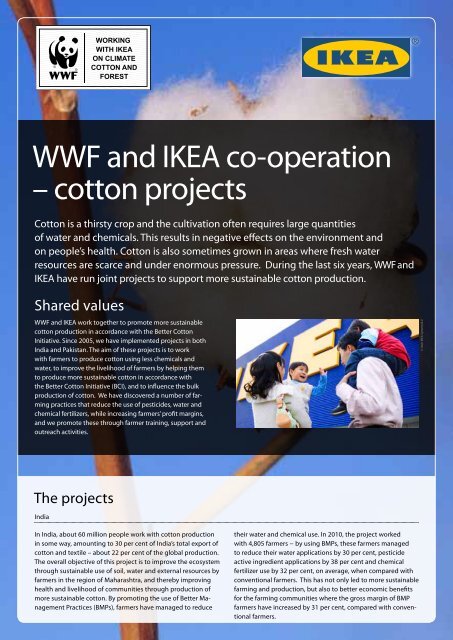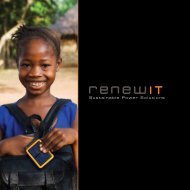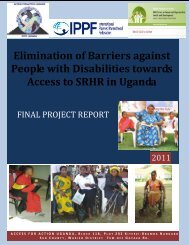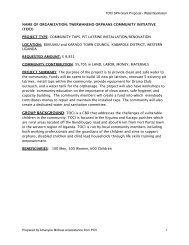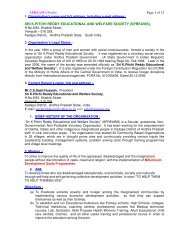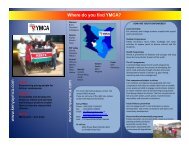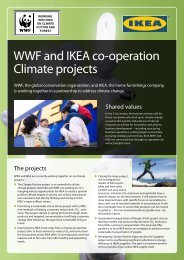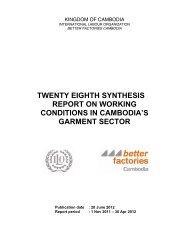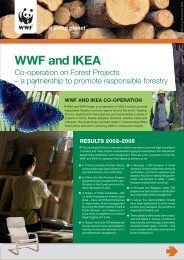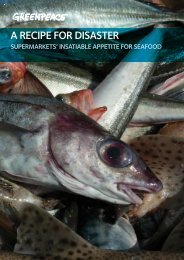WWF and IKEA co-operation â cotton projects - Global Hand
WWF and IKEA co-operation â cotton projects - Global Hand
WWF and IKEA co-operation â cotton projects - Global Hand
You also want an ePaper? Increase the reach of your titles
YUMPU automatically turns print PDFs into web optimized ePapers that Google loves.
WORKING<br />
WITH <strong>IKEA</strong><br />
ON CLIMATE<br />
COTTON AND<br />
FOREST<br />
<strong>WWF</strong> <strong>and</strong> <strong>IKEA</strong> <strong>co</strong>-<strong>operation</strong><br />
– <strong>co</strong>tton <strong>projects</strong><br />
© <strong>WWF</strong>-Canon / <strong>WWF</strong>-Switzerl<strong>and</strong>/A. della Bell<br />
Cotton is a thirsty crop <strong>and</strong> the cultivation often requires large quantities<br />
WF<br />
of water<br />
<strong>and</strong> chemicals.<br />
<strong>IKEA</strong><br />
This results<br />
<strong>co</strong>-<strong>operation</strong><br />
in negative effects on the environment <strong>and</strong><br />
on people’s health. Cotton is also sometimes grown in areas where fresh water<br />
F, the resources global <strong>co</strong>nservation are scarce <strong>and</strong> organization, under enormous <strong>and</strong> <strong>IKEA</strong>, pressure. the home During furnishings the last six <strong>co</strong>mpany, years, <strong>WWF</strong> <strong>and</strong><br />
working <strong>IKEA</strong> together have run in a joint partnership <strong>projects</strong> to to support promote more responsible sustainable forestry <strong>co</strong>tton <strong>and</strong> production. better <strong>co</strong>tton<br />
duction, <strong>and</strong> to address climate change.<br />
Shared values<br />
<strong>WWF</strong> <strong>and</strong> <strong>IKEA</strong> work together to promote more sustainable<br />
<strong>co</strong>tton production in ac<strong>co</strong>rdance with the Better Cotton<br />
ARED Initiative. VALUES<br />
Since 2005, we have implemented <strong>projects</strong> in both<br />
India <strong>and</strong> Pakistan. The aim of these <strong>projects</strong> is to work<br />
F <strong>and</strong> <strong>IKEA</strong> are both <strong>co</strong>mmitted to promoting the responsible<br />
with farmers to produce <strong>co</strong>tton using less chemicals <strong>and</strong><br />
ustainable use of natural resources for present <strong>and</strong> future needs.<br />
water, to improve the livelihood of farmers by helping them<br />
Co-<strong>operation</strong> to produce is founded more on sustainable each organization’s <strong>co</strong>tton in ac<strong>co</strong>rdance unique with <strong>co</strong>mpeies<br />
which they Better bring Cotton to their Initiative joint (BCI), <strong>projects</strong>. <strong>and</strong> to These influence <strong>projects</strong> the bulk are<br />
rtant steps production in implementing of <strong>co</strong>tton. <strong>IKEA</strong>´s We have Social dis<strong>co</strong>vered <strong>and</strong> a Environmental<br />
number of farming<br />
achieving practices <strong>WWF</strong>´s that reduce global the <strong>co</strong>nservation use of pesticides, targets. water Wor-<br />
<strong>and</strong><br />
egy <strong>and</strong> in<br />
together, more chemical can fertilizers, be achieved. while increasing farmers’ profit margins,<br />
<strong>and</strong> we promote these through farmer training, support <strong>and</strong><br />
THER outreach activities.<br />
ACHIEVING RESULTS<br />
© Inter <strong>IKEA</strong> Systems B.V.<br />
The <strong>WWF</strong> <strong>and</strong> <strong>IKEA</strong> <strong>co</strong>-<strong>operation</strong> first began in 2002 to jointly promote responsible<br />
forestry. The first years of <strong>co</strong>-<strong>operation</strong> showed that by working together, <strong>WWF</strong> <strong>and</strong><br />
<strong>IKEA</strong> can achieve more in helping to <strong>co</strong>nserve the world’s forests. In 2005, <strong>WWF</strong><br />
<strong>and</strong> <strong>IKEA</strong> identified additional areas of <strong>co</strong>mmon interest, such as reducing the environmental<br />
<strong>and</strong> social impacts of <strong>co</strong>nventional <strong>co</strong>tton production <strong>and</strong> addressing<br />
The <strong>projects</strong><br />
India<br />
climate change issues. A summary of achievements from the first three years of the<br />
<strong>co</strong>-<strong>operation</strong> on forest <strong>projects</strong> is available on www.p<strong>and</strong>a.org/ikea.<br />
In India, about 60 million people work with <strong>co</strong>tton production their water <strong>and</strong> chemical use. In 2010, the project worked<br />
in some way, amounting to 30 per cent of India’s total export of with 4,805 farmers − by using BMPs, these farmers managed<br />
<strong>co</strong>tton <strong>and</strong> textile – about 22 per cent of the global production. to reduce their water applications by 30 per cent, pesticide<br />
The overall objective of this project is to improve The <strong>projects</strong> the e<strong>co</strong>system have resulted in active <strong>co</strong>ncrete, ingredient positive applications out<strong>co</strong>mes, particularly by 38 per cent in responsible <strong>and</strong> chemical<br />
through sustainable use of soil, water <strong>and</strong> forestry external management resources by <strong>and</strong> education fertilizer about use sustainable by 32 per cent, <strong>co</strong>tton on production. average, when For example: <strong>co</strong>mpared with<br />
farmers in the region of Maharashtra, <strong>and</strong> there by improving <strong>co</strong>nventional farmers. This has not only led to more sustainable<br />
Demonstration forests have been established to show forest<br />
health <strong>and</strong> livelihood of <strong>co</strong>mmunities through owners production <strong>and</strong> managers of the farming benefits <strong>and</strong> of responsible production, forestry. but also to better e<strong>co</strong>nomic benefits<br />
more sustainable <strong>co</strong>tton. By promoting the use Three of Better global Management<br />
Practices (BMPs), farmers have managed <strong>co</strong>untries to reduce to help identify farmers <strong>and</strong> manage have particularly increased important by 31 per cent, <strong>co</strong>mpared with <strong>co</strong>nven-<br />
tool kits have for been the produced farming <strong>co</strong>mmunities <strong>and</strong> tested in where various the gross margin of BMP<br />
forest areas – High Conservation tional farmers. Value Forests (HCVFs) – <strong>and</strong><br />
to en<strong>co</strong>urage certification <strong>and</strong> improved forest management.<br />
In Russia many <strong>co</strong>mpanies have <strong>co</strong>mmitted to responsible<br />
© Inter <strong>IKEA</strong> Systems B.V.
WORKING<br />
WITH <strong>IKEA</strong><br />
ON CLIMATE<br />
COTTON AND<br />
FOREST<br />
CONTACT. For more information on<br />
the <strong>WWF</strong> <strong>and</strong> <strong>IKEA</strong> <strong>co</strong>-<strong>operation</strong>, visit<br />
www.p<strong>and</strong>a.org/ikea or <strong>co</strong>ntact <strong>WWF</strong> at<br />
wwf-ikea-<strong>projects</strong>@wwf.se or www.ikea.<strong>co</strong>m<br />
Pakistan<br />
Pakistan is the fourth largest producer of <strong>co</strong>tton in the world,<br />
after China, India <strong>and</strong> the US − with about 8 per cent of the<br />
total global <strong>co</strong>tton production.<br />
The overall objective of the <strong>co</strong>tton project is to improve farmers´<br />
livelihoods through the introduction of BMPs in three districts<br />
of Pakistan. This will ensure a sustainable improve ment in<br />
the natural, financial, social <strong>and</strong> human capital available to the<br />
<strong>co</strong>tton farmers, <strong>and</strong> promote its adoption throughout Pakistan<br />
as well as internationally. <strong>WWF</strong> also aims to build the capacity of<br />
farmers to meet the BCI criteria, which would have environmental<br />
<strong>and</strong> livelihood benefits. By using the BMPs, around 42,000<br />
farmers in Pakistan were targeted in 2010 <strong>and</strong> changed their<br />
farming methods to be more sustainable <strong>and</strong> less water <strong>and</strong><br />
chemical dependent. Organic manures <strong>and</strong> <strong>co</strong>mposts are used,<br />
pest risks <strong>and</strong> nutrient <strong>and</strong> water needs of the <strong>co</strong>tton plant are<br />
better assessed. In 2010, the BMP <strong>co</strong>tton farmers made crop<br />
management decisions which, when <strong>co</strong>mpared with <strong>co</strong>nventional<br />
farmers, reduced the use of chemical fertiliser by 41 per cent,<br />
reduced irrigation water use by 38 per cent <strong>and</strong> reduced the pesicide<br />
’active ingredient’ applications by 47 per cent on average.<br />
This has not only led to more sustainable farming <strong>and</strong> production,<br />
but also to better e<strong>co</strong>nomic benefits for the farming <strong>co</strong>mmunities<br />
where the gross margin of BMP farmers have increased<br />
by 24 per cent when <strong>co</strong>mpared with <strong>co</strong>nventional farmers.<br />
Better Cotton Initiative<br />
© Inter <strong>IKEA</strong> Systems B.V.<br />
<strong>WWF</strong> <strong>and</strong> <strong>IKEA</strong> are two of the founding members of<br />
the Better Cotton Initiative (BCI), <strong>and</strong> also members<br />
of its Steering Committee. <strong>WWF</strong> <strong>and</strong> <strong>IKEA</strong> promote<br />
the objectives of BCI, <strong>and</strong> support farmers to achieve<br />
the BCI criteria, <strong>and</strong> thereby produce more sustainable <strong>co</strong>tton.<br />
Read more on www.better<strong>co</strong>tton.org<br />
More information about the <strong>projects</strong> can also be found<br />
on www.p<strong>and</strong>a.org/ikea.<br />
Summary of results:<br />
The <strong>projects</strong> in Pakistan <strong>and</strong> India have shown significant<br />
results, proving that it is possible to produce <strong>co</strong>tton at a<br />
lower <strong>co</strong>st, which improves the gross margins for the<br />
farmer, while reducing the use of agrochemicals <strong>and</strong> water<br />
inputs. Below are some of the results from the <strong>projects</strong> in 2010<br />
by farmers using BMPs, as <strong>co</strong>mpared to <strong>co</strong>nventional farmers,<br />
which give an indication of what can be achieved.<br />
In Pakistan, during 2010, when <strong>co</strong>mpared with <strong>co</strong>nventional<br />
farmers:<br />
■■<br />
the average reduction in pesticide active ingredient by BMP<br />
farmers was 47 per cent<br />
■■<br />
the average reduction in chemical fertilizer use by BMP<br />
farmers was 41 per cent<br />
■■<br />
the average reducation in water use by BMP famers was 38<br />
per cent<br />
■■<br />
the average increase in gross margins was 24 per cent<br />
■■<br />
the number of farmers involved in the project was 41,970<br />
■■<br />
the number of hectares farmed using BMPs was 161,877<br />
In India, during 2010, when <strong>co</strong>mpared with <strong>co</strong>nventional<br />
farmers:<br />
■■<br />
the average reduction in pesticide active ingredient by BMP<br />
farmers was 38 per cent<br />
■■<br />
the average reduction in chemical fertilizer use by BMP<br />
farmers was 32 per cent<br />
■■<br />
the average reducation in water use by BMP famers was 30<br />
per cent<br />
■■<br />
the average increase in gross margins was 31 per cent<br />
■■<br />
the number of farmers involved in the project was 4,805<br />
■■<br />
the number of hectares farmed using BMPs was 10,000<br />
DVALA is made of<br />
more sustainable <strong>co</strong>tton.<br />
The number of hectares that was farmed in Pakistan <strong>and</strong> India<br />
during 2010 with BMP was 176,262 <strong>and</strong> appr. 51,000 farmers<br />
were practising BMP when growing <strong>co</strong>tton.


